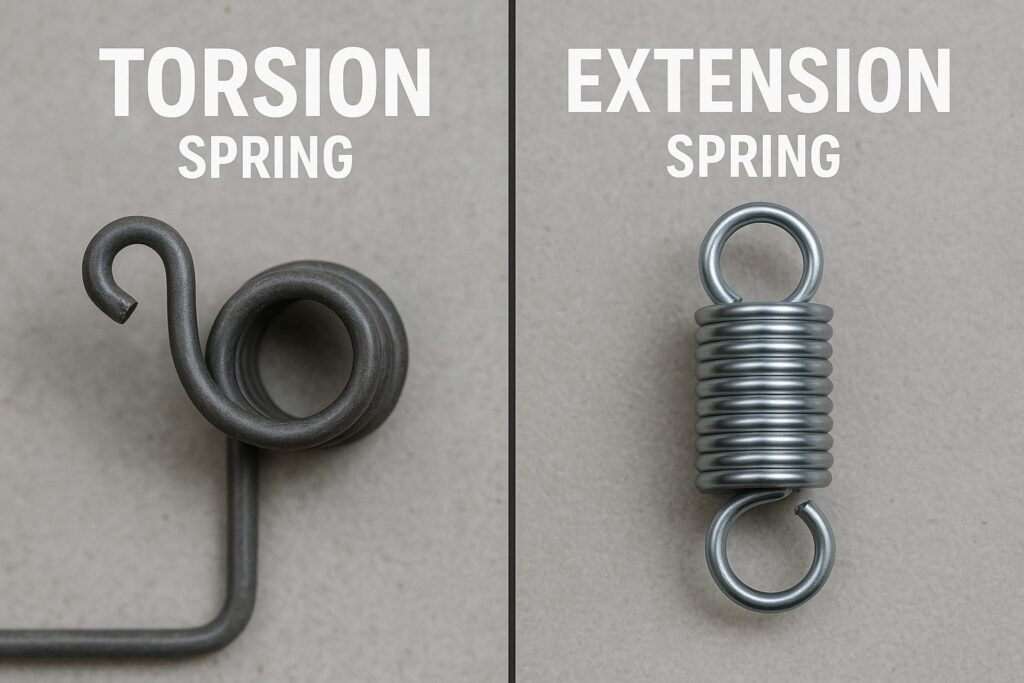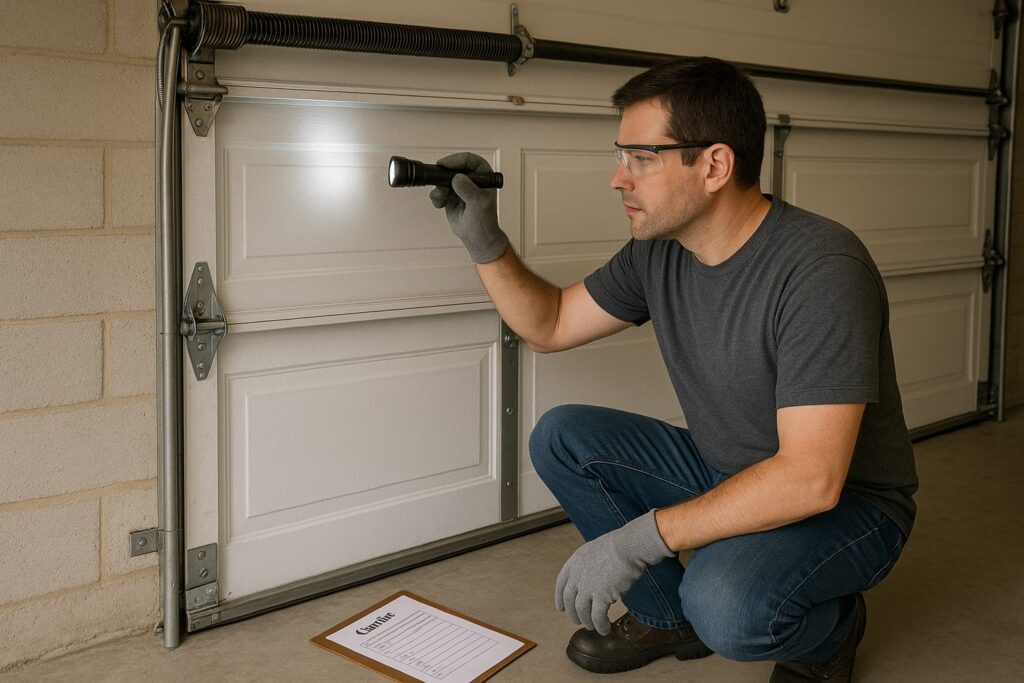What Causes Garage Door Springs to Snap: Insights from Emergency Garage Door Repair in Nebraska

Garage doors are an essential part of modern homes and commercial properties, providing security, convenience, and aesthetic appeal. Yet, when a garage door stops functioning properly, it often causes immediate disruption and concern. One of the most frequent and potentially dangerous issues that property owners face is a broken garage door spring. This small but critical component is often taken for granted until it fails, requiring prompt attention and emergency repair.
At Seacrest Garage Doors Co., we regularly respond to urgent calls for emergency garage door repair involving snapped springs. These calls come from homeowners and business operators who suddenly find themselves unable to access or secure their property. In one such case in Lincoln, a homeowner experienced a complete failure of their garage door system late at night due to a broken torsion spring. Their vehicle was trapped inside, and they were unable to leave for an out-of-town emergency. Our team arrived within the hour, replaced the spring, inspected the rest of the door system, and ensured that everything was functioning safely before leaving. This situation highlights the importance of understanding the causes and prevention of spring failure.
Statistically, most garage door springs are engineered to last around 10,000 cycles. For the average homeowner, this equates to about 7 to 10 years of use. However, in high-use households or commercial settings, that lifespan can be significantly shorter. In warmer states like Nebraska and California, extreme weather conditions and higher humidity levels contribute to faster wear and tear. This makes timely maintenance and professional inspection all the more crucial. Let’s explore the core reasons garage door springs snap and how to prevent this common emergency.
Understanding Garage Door Springs
Garage door springs are essential for the operation of any garage door system. They counterbalance the weight of the door, making it easier to lift manually or with a garage door opener. Without them, the door would be too heavy to open or close safely. There are two primary types of springs used in residential and commercial garage doors: torsion springs and extension springs.
Torsion springs are installed above the garage door and twist to store mechanical energy. They are typically used in heavier doors and provide smoother, more controlled motion. Extension springs, on the other hand, are mounted on the sides of the door and stretch when the door is closed, releasing energy as it opens. While both types perform similar functions, torsion springs tend to be more durable and are recommended for most applications.

These springs are made from high-tension steel and are tightly wound, allowing them to store and release energy efficiently. However, this tension also makes them dangerous to handle without the proper tools and training. A sudden release of energy from a broken spring can cause severe injury or property damage. That’s why it’s important to have any spring-related repairs handled by certified garage door technicians.
When a spring breaks, the door can become misaligned, difficult to open, or completely stuck. This not only disrupts your daily routine but can also compromise the security of your home or business. Regular inspections and maintenance can help identify early signs of wear and ensure your springs are in good condition.
Main Causes of Garage Door Spring Failure
1. Natural Wear and Tear
The most common cause of garage door spring failure is simple wear and tear. Every time you open or close your garage door, the springs stretch or twist and release energy. Over time, this repeated action fatigues the metal, leading to eventual breakage. Standard springs are rated for around 10,000 cycles, which may last seven to ten years under normal usage.
However, homes with multiple drivers, busy households, or commercial properties may go through many more cycles per day. In such cases, the lifespan of the spring can be reduced to just a few years. Investing in high-cycle springs, which are designed to last 20,000 to 50,000 cycles, can provide a more durable and long-term solution.
To prolong the life of your garage door springs, limit unnecessary door use and consider upgrading if your home or business relies heavily on garage access. It’s also a good idea to document how often the door is used to better estimate when maintenance or replacement will be needed.
2. Rust and Corrosion
Rust is another major factor in spring failure. When moisture accumulates on the steel coils, it causes oxidation that gradually eats away at the metal. This weakens the structure of the spring and increases friction during operation, making it more susceptible to breakage.
Rust is particularly problematic in humid climates or areas where garages are not well ventilated. For example, coastal regions in California often experience higher moisture levels that accelerate corrosion. To combat rust, apply a silicone-based garage door lubricant to the springs every few months. This creates a protective barrier and ensures smoother operation.
In addition to regular lubrication, inspect your garage for water leaks, damp spots, or inadequate insulation. Installing a dehumidifier or improving airflow can also help prevent rust and extend the life of your door components.
3. Temperature Fluctuations
Temperature extremes can significantly impact the integrity of garage door springs. In regions like Nebraska, where temperatures can swing from freezing in winter to over 100°F in summer, the metal in the springs expands and contracts repeatedly. This thermal cycling leads to metal fatigue, especially when combined with other stressors like rust or excessive use.
Cold temperatures can make the metal brittle, increasing the likelihood of a sudden break. In contrast, extreme heat can cause lubricants to evaporate, increasing friction and wear. Homeowners can mitigate these effects by insulating their garage and scheduling seasonal maintenance checks in the spring and fall.
Technicians can examine the condition of the springs, lubricate moving parts, and make adjustments to ensure your door operates smoothly despite the weather. Keeping your garage environment stable not only protects your springs but also preserves the overall health of your garage door system.
4. Low-Quality Springs
Not all springs are created equal. Some garage door systems, particularly those installed by less reputable contractors or DIYers, use low-grade or improperly sized springs. These springs may not be rated for the weight of your door or may be manufactured from subpar materials that fail under stress.
Cheap springs might save money upfront, but often lead to more frequent failures and costly repairs in the long run. At Seacrest Garage Doors Co., we use only premium, oil-tempered, high-cycle springs that offer superior durability and performance.
When choosing a garage door service provider, ask about the types of springs they use, warranty coverage, and installation practices. A trustworthy company will be transparent about its materials and offer long-term solutions, not just temporary fixes.
5. Improper Installation
Incorrect installation is another leading cause of premature spring failure. Springs must be precisely matched to the weight and dimensions of your garage door. Even small miscalculations can place uneven stress on the spring system, leading to early wear or sudden breakage.
Poor installation can also create imbalance, causing the door to lift unevenly, strain the opener, or damage other components. These issues can remain hidden for months before resulting in a major failure. That’s why it’s essential to have your garage door installed or serviced by experienced, certified technicians.
Professional installers use calibration tools and follow manufacturer guidelines to ensure every component functions harmoniously. They will also perform a complete system test before leaving your property, giving you peace of mind and minimizing future risks.
6. Lack of Maintenance
Neglecting regular maintenance is perhaps the easiest mistake to avoid. Like any mechanical system, your garage door needs routine care to operate efficiently and safely. This includes inspecting for wear, tightening hardware, lubricating moving parts, and testing balance and alignment.
A proactive maintenance schedule allows you to catch problems early, such as fraying cables, squeaking springs, or slow-moving openers, before they escalate into costly emergencies. Seacrest Garage Doors Co. offers affordable maintenance plans that include a thorough 20-point inspection, spring adjustment, and performance tune-up.
By investing a little time and money into preventative care, you can significantly extend the life of your garage door system and avoid unexpected disruptions.
Warning Signs Your Springs Are About to Break
Being able to recognize early warning signs of a failing garage door spring can save you from sudden breakdowns and emergency repair situations. Many homeowners overlook subtle symptoms until it’s too late. Staying alert and proactive can not only prevent accidents but also protect your garage door opener, door panels, and track system from further damage.
Visual Clues
Carefully inspect the springs for visible signs of deterioration. Common indicators include gaps in the coils, rust spots, or uneven stretching. A good spring should be tightly wound with no signs of warping or fraying. If you notice a two-inch or larger gap in the torsion spring, it’s likely already broken and needs replacement.
Audible Clues
Listen for loud banging, popping, or creaking sounds during garage door operation. These noises often occur when a spring is under stress or about to snap. If your garage door opens with a jerky motion or makes a grinding noise, it’s a strong indication that the spring system is compromised.
Operational Clues
Pay attention to how your door behaves. A door that closes too quickly, opens unevenly, or feels excessively heavy when operated manually may have a worn or broken spring. Additionally, if the automatic opener struggles or fails to lift the door completely, the springs may no longer be providing the necessary counterbalance.
The Dangers of DIY Garage Door Spring Repair
While it might be tempting to tackle garage door repairs yourself, attempting to fix or replace springs without proper training is extremely dangerous. Garage door springs are wound tightly under immense tension. When they snap or release unexpectedly, they can cause severe injuries such as broken bones, deep cuts, or even blindness.
Emergency rooms across the United States report thousands of injuries each year due to DIY garage door repairs gone wrong. One homeowner in Lincoln, NE attempted to replace his torsion spring using makeshift tools. The spring recoiled and hit his arm, resulting in a fracture and weeks of recovery. The cost of medical treatment far outweighed the price of professional repair.
Certified technicians, like those at Seacrest Garage Doors Co., use specialized tools and safety equipment to perform spring repairs correctly and safely. They also have the expertise to identify related issues, ensuring your entire garage door system is functional and secure.
How the Weather in Nebraska Affects Garage Door Springs
Nebraska weather is known for its volatility, scorching summers, sudden cold fronts, high humidity, and frequent storms. These environmental conditions accelerate the wear and tear of garage door components, particularly springs.
During hot months, temperatures inside garages can exceed 120°F, causing metal parts to expand and lubricants to evaporate. This increases friction between moving parts, leading to faster deterioration. Conversely, in winter, cold temperatures make steel more brittle, raising the risk of sudden breakage.
Humidity and moisture can also lead to rust and corrosion. Homes near the coast or in regions with high rainfall are particularly vulnerable. Spring failures are especially common during seasonal transitions when temperature swings are most drastic.
To combat these weather-related challenges, homeowners in Nebraska and similar climates should invest in insulated garage doors, weather-sealed enclosures, and schedule seasonal inspections. These measures can help stabilize the garage environment and preserve your garage door’s structural integrity.
What to Do When a Spring Breaks
If your garage door spring breaks, the most important thing is to stay calm and take the right steps to ensure safety and minimize damage.
Step 1: Stop Using the Door
Avoid operating the door manually or with the automatic opener. Doing so can cause further damage to the tracks, cables, and motor. A stuck or unbalanced door can also collapse suddenly, posing a safety risk.
Step 2: Secure the Area
Make sure the garage door is fully closed or secured in place. Keep children, pets, and vehicles away from the area. If the door is partially open and stuck, prop it securely with blocks or braces to prevent accidental falls.
Step 3: Call a Professional for Emergency Garage Door Repair
Contact a trusted local garage door company that offers 24/7 emergency services. Explain the issue clearly and request an immediate inspection. Prompt professional attention can prevent further complications and get your door functioning again quickly.
At Seacrest Garage Doors Co., our technicians are available around the clock to assist homeowners and businesses with urgent repair needs. We carry a full inventory of replacement parts and tools to resolve most spring failures on the first visit.
Preventive Tips to Extend Garage Door Spring Life
Regular maintenance and smart usage practices can greatly extend the lifespan of your garage door springs and reduce the risk of unexpected failure. Here are some proven tips to help you maintain a reliable garage door system:

- Lubricate Springs and Moving Parts: Use a high-quality silicone spray or garage door lubricant on springs, rollers, hinges, and tracks every 3–6 months. This reduces friction and prevents rust.
- Schedule Annual Inspections: Have a qualified technician perform a full inspection of your garage door system once a year. This includes checking spring tension, alignment, and overall wear.
- Limit Excessive Use: If your household uses the garage door as the primary entrance, consider limiting usage or installing a high-cycle spring to accommodate the additional wear.
- Balance Check: Test the door’s balance by disconnecting the opener and manually lifting the door halfway. If it doesn’t stay in place, the springs may be worn or improperly tensioned.
- Upgrade to High-Cycle Springs: For busy homes or commercial properties, upgrading to high-cycle springs (rated for 20,000+ cycles) can significantly improve durability.
By implementing these maintenance habits, you can improve your garage door’s reliability and ensure long-term safety and performance.
How Can Seacrest Garage Doors Co. Help You?
At Seacrest Garage Doors Co., we take pride in delivering expert, high-quality garage door solutions that meet the needs of homeowners and businesses throughout Lincoln, NE, and surrounding areas. Our services are backed by years of experience, a commitment to safety, and a customer-first approach.
Our Emergency Repair Services Include:
- 24/7 availability for urgent garage door issues
- Fast response times and fully stocked service vehicles
- Comprehensive diagnosis and on-the-spot spring replacement
- Repair of door openers, cables, tracks, and other components
- Post-repair inspections and performance testing
Why Choose Seacrest Garage Doors Co.?
- Licensed and insured technicians with extensive training
- Only high-grade, oil-tempered, and high-cycle springs used
- Clear pricing, no hidden fees, and satisfaction guarantees
- Locally owned and operated with a strong reputation for excellence
Whether you’re dealing with a broken spring, malfunctioning opener, or planning a new garage door installation, our team is here to help. We work with all major brands, including Door-Mart Garage Doors, Aladdin Garage Doors, Precision Garage Door, and more.
📍 Address: 6891 A St #104, Lincoln, NE 68510
📞 Phone: (402) 374-9880
📧 Email: [email protected]
🌐 Website: seacrestgaragedoorsco.com
Don’t wait until it’s too late. Contact us today to schedule a maintenance check, book an installation, or get immediate assistance for your garage door emergency.
Final Thoughts
A broken garage door spring is more than an inconvenience; it can be a serious safety issue that puts your family, property, or business at risk. Understanding the causes of spring failure, recognizing the warning signs, and taking preventive measures are key to avoiding emergencies.
At Seacrest Garage Doors Co., we believe that proactive care and professional service go hand-in-hand. From spring replacements to new garage door installations, our technicians are here to keep your door functioning reliably and safely. We serve both residential and commercial clients with tailored solutions that prioritize durability, safety, and customer satisfaction.
If your garage door isn’t working right or you’re concerned about potential issues, don’t hesitate to reach out. Our expert team is standing by to provide peace of mind and fast, effective solutions for all your garage door needs.
Secure your garage. Protect your property. Call Seacrest Garage Doors Co. today.
Frequently Asked Questions (FAQs)
1. Can I still open my garage door manually if the spring is broken?
Yes, but it is not recommended—lifting a heavy garage door without spring support can be dangerous and cause injury or additional damage.
2. How much does it cost to replace a garage door spring?
On average, professional spring replacement costs between $150 to $350, depending on the type of spring and labor involved.
3. Are garage door springs covered under warranty?
Many manufacturers offer warranties for garage door springs ranging from 1 to 10 years, but coverage depends on the product and installer.
4. How do I know which type of spring my garage door uses?
Torsion springs are mounted horizontally above the door, while extension springs run parallel to the door tracks along the sides.
